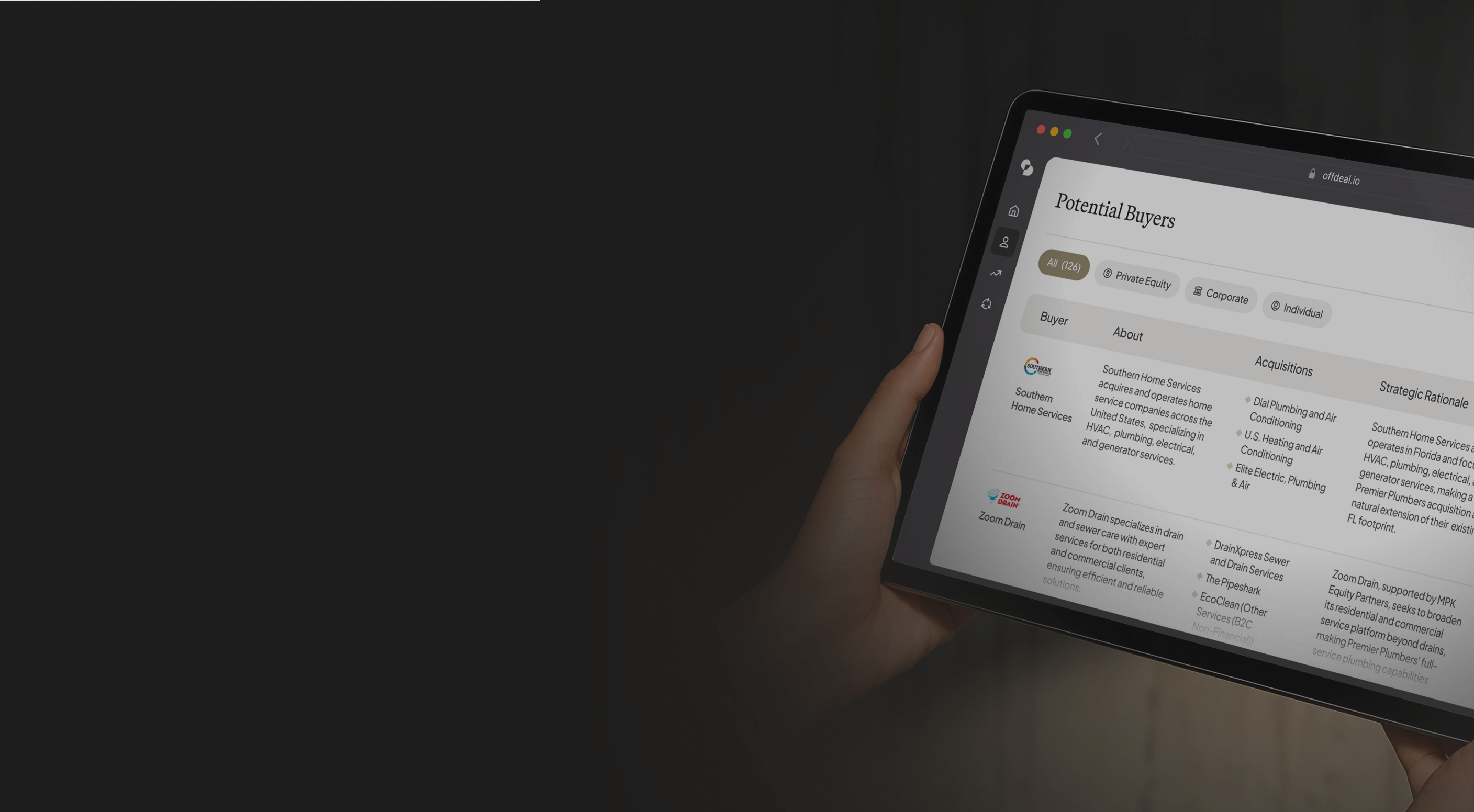Article
August 10, 2025
Developing Standard Operating Procedures When Preparing to Sell Your Assisted Living Business
Selling your assisted living business? Discover effective SOPs that can boost valuation, attract buyers, and ensure a smooth ownership transition.

Table of Contents
You've dedicated countless hours into growing your assisted living business into an enterprise you can proudly call your legacy. But now, you're seriously thinking about passing the baton—whether that's to secure a comfortable retirement, pursue a new venture, or simply capitalize on all the hard work you’ve invested. However, as the reality of exiting your business comes into view, a critical question remains: how will you make sure your assisted living facility achieves maximum market value when it's time to sell?
Interestingly, the single most overlooked factor when preparing to sell an assisted living business isn’t necessarily upgraded facilities, luxurious amenities, or marketing hype. It's having strong, carefully documented Standard Operating Procedures (SOPs).
In fact, documented SOPs can significantly enhance your negotiation position, boost your valuation numbers, and reassure prospective buyers that your business can successfully sustain and scale—no matter who sits at the helm.
In this article, you'll learn:
Why documented SOPs heavily influence your assisted living business valuation
Which core processes deserve well-crafted SOPs in assisted living businesses
A clear step-by-step SOP creation framework tailored specifically for assisted living businesses
Practical advice and common pitfalls to avoid while developing your SOPs
Real-life examples highlighting the value effective SOPs offer assisted living sellers
Whether exiting is firmly etched onto your calendar or is yet years away, today’s the ideal time to strengthen your assisted living facility's value through leveraging practical, buyer-friendly SOPs.
Why SOPs Are Crucial When Selling an Assisted Living Business
Prospective buyers keenly evaluate assisted living businesses by asking a straightforward—but critical—question: "Can this business operate successfully without its existing owner?" If vital processes are undocumented and daily operations depend significantly on your personal input, it raises red flags and hurts buyer confidence—often significantly decreasing the price you can achieve.
Reducing Owner Dependency and Business Risk
In assisted living, owner-reliance poses serious buyer concerns regarding ongoing operational quality, compliance, and effectiveness. With clearly documented SOPs, you're showing potential buyers that essential tasks and crucial operational duties—from caregiving standards to emergencies—are robust, documented, and maintainable regardless of owner presence.
Enabling Operational Scalability and Growth
Buyers look for businesses with clear potential for growth and scalability. SOPs represent tested methods that easily adapt to expansion (e.g., adding new facilities or accommodating additional residents smoothly). Precise documented operating procedures allow new ownership to quickly onboard staff, replicate success, and enhance overall operational efficiency and profitability.
Improved Valuation Multipliers
To appreciate SOPs' tangible financial difference, consider this comparative valuation example:
| Valuation Metric | Without Documented SOPs | With Robust Documented SOPs |
|---|---|---|
| Owner-Dependence | High (Lower Price/High Risk) | Low (Increased Valuation/Lower Risk) |
| Buyer Confidence | Reduced | Increased |
| Likely Selling Price (SDE multiplier example) | 2–3× SDE | 4–5× SDE |
This difference can easily translate into hundreds of thousands or even millions of extra dollars upon successfully selling your assisted living facility.
Key Processes to Document in Assisted Living Business SOPs
Not every activity within your business requires detailed SOP documentation. Rather, concentrate on those operations and processes directly impacting quality of care, regulatory compliance, customer satisfaction, and profitability. Prioritize effectively by documenting these critical areas first:
Resident Care Management Procedures
A properly documented care management system gives buyers confidence in standard care procedures:
Intake assessments, evaluations, and individualized care plans
Medication management policies and routine medication administration guidelines identified by regulation
Emergency medical response procedures, including escalation protocols and communication processes
Resident safety routines and monitoring checks, including resident transfers and mobility assistance
Facilities Management & Maintenance Procedures
Professionally maintained premises and structured SOPs reassure buyers of smoother property upkeep:
Routine maintenance schedules and checklists for housekeeping, repairs, landscaping, and sanitation
Emergency procedures for facility-wide incidents (fire, evacuation, power outage, severe weather scenarios)
Procedures for ensuring regulatory compliance and facility inspections by authorities
Employee Training, Staffing, and Management
Confidently transferable staffing structures substantially reduce buyer worries about ongoing operations:
New employee onboarding and orientation checklists (including licensing and credential verification)
Customized training protocols for caregivers, kitchen staff, housekeeping, and administrative employees
Clear HR processes and personnel policies (performance appraisals, grievance reporting, disciplinary protocols, schedules, breaks, overtime authorization)
Marketing, Sales & Admissions Procedures
Buyers want reassurance about continuous resident enrollment:
Marketing strategies including referral relationships, community outreach, digital marketing efforts, tours, and open houses
Admission inquiries, touring, information packages, and follow-up communication checklists
Resident admissions procedures, paperwork, billing, and initial welcoming/orientation practices
Compliance and Record-Keeping Procedures
Regulatory compliance is indispensable to buyers in the assisted living industry. SOPs are essential here:
Daily documentation requirements for caregiving, incidents, and health monitoring
Regular compliance audits and annual licensing inspections checklists
Procedures for maintaining accurate records (resident files, staff certifications, health and safety inspections)
Financial Administration & Billing Procedures
Buyers need financial transparency and predictable revenue systems:
Clear billing and collections procedures for timely resident billing
Vendor payments, payroll management procedures, and inventory purchasing guidelines
Routine financial reporting, reconciliations, auditing procedures, and controlling budget adherence
Creating SOPs for Your Assisted Living Business — Step-by-Step Guidance
Developing effective SOPs doesn't have to be complicated. Here's how you can clearly document your essential processes:
Step 1: Identify Major Critical Processes
List and prioritize significant operating areas, then outline detailed tasks required within each critical process of everyday operations.
Step 2: Clearly Record Current Practices
Observe key staff performing tasks. Consult directly with your experienced team members, then clearly capture each step sequentially, using photos, flowcharts, or diagrams as needed to illustrate complex tasks.
Step 3: Write User-Friendly, Simple SOP Documents
Clarify responsibility assignments and use clear, concise language consistently. Begin with bullet-pointed steps to keep procedures straightforward and digestible.
Example SOP snippet (Medication Administration Guidelines):
Verify resident identity per photo ID or wristband per state guidelines.
Check medication record against scheduled prescription.
Administer medication correctly per prescribed dosage method.
Document administration accurately following required records procedures.
Observe the resident briefly for adverse reaction or side-effects.
Step 4: Test, Review & Refine Regularly
Ask experienced caregivers and junior employees alike to test-drive SOP drafts. Regularly revise based on employee suggestions and improvements.
Step 5: Continuously Maintain and Update
Consider SOPs as living documents, not static paperwork. Schedule regular audits (at least annually) and update immediately after any regulatory changes or significant process adjustments.
Avoid Common SOP Development Mistakes
Avoid pitfalls common among assisted living business owners drafting SOPs:
Unnecessary Complexity: Keep SOPs simple, clear, and actionable.
Ignoring Staff Input: Tap directly into your employees’ practical, frontline experience.
Overuse of Technical Language: Use plain, accessible language understandable by any staff member.
One-Time Effort: Periodically revisit and update procedures regularly to keep them current.
Real-Life Context: Assisted Living SOP Impact on Valuation
Consider two comparable assisted living facilities preparing for sale:
| Business Element | OakCrest Assisted Care (Strong SOPs) | SunnyHaven Assisted Living (Minimal SOPs) |
|---|---|---|
| Annual Revenue | $1,950,000 | $2,000,000 |
| Owner Dependency | Low (Operational autonomy) | High |
| Staff Efficiency and Stability | High, consistent | Variable, inconsistent |
| Regulatory Compliance Confidence | Strong & consistent | Potential liabilities |
| Buyer Confidence | High | Low |
| Final Selling Price (approx. SDE multiplier) | 4-5× (~ $1.1M valuation) | 2-3× (Under $600k valuation) |
This example clearly shows the dramatic financial advantage robust SOP documentation offers in assisted living business sales.
Final Thoughts: Act Now for a Rewarding Exit Strategy
You never know precisely when you’ll be ready to hand your assisted living business to new owners. Missing out on deserved valuation increases is an avoidable mistake. Clearly documented Standard Operating Procedures bridge gaps that determine a massive difference in final sale value.
Clearly documented SOPs provide achievable pathways to growth, consistent quality, regulatory compliance, stable operations, and reduced owner dependency. By investing consistently now in detailed SOP creation, your assisted living facility will sidestep common pitfalls and position itself as a compelling, turnkey business frontrunner—maximizing your financial rewards and delivering peace of mind when it’s finally time to pass along your legacy.

Preview Buyers for Free
Try our buyer match tool to receive a personalized list of active buyers in your industry

